The colonnade of St. Isaac’s Cathedral is the best viewing point in central St. Petersburg. 43 meters high above the downtown provide a 360-degree-panorama with major landmarks and marvelous landscapes below. It’s also accessible for disabled people. Read our guide and recommendations carefully before visiting as there are things you should keep in mind.
Information on this page has been updated in March 2021.
Essentials To The Visit To The Colonnade
The cathedral has two viewing points. Tourists have access to the lower only, which is marked on the photo:

It’s a circle viewing platform formed around the cathedral’s cupola by 24 massive 64-ton granite columns. It’s an impressive outstanding construction that required advanced and maybe even risky engineering solutions on the part of the architect August Montferrand.
Address: 4, St. Icaas’s square
Opening hours:
from May 1 till October 31: 10.00 – 18.00 daily
from November 1 till April 30: 10.00 – 18.00 daily expect third Wednesday of each month
A visit to the colonnade in the evening:
18.00 – 22.30 from April 27 till September 30.
Box offices close 30 minutes before the end of work.
Cost: 200 rubles per person in the daytime, 400 rubles in the evening. A ticket to the colonnade doesn’t include a ticket to the cathedral’s main exposition located inside the building.
You can buy tickets both in box offices near the cathedral and online. You need to have your electronic ticket printed so that a turnstile could read its barcode.
Recommendations:
• you will have to climb a long spiral staircase. Not that you need to be an athlete to overcome it, but if you struggle to go up a usual staircase without having a sense of feeling winded, you’d better quit the visit. Its 562 footsteps look like that:

• after the spiral staircase there is another staircase. A passage between the staircases is only 70 cm wide. Full-figured, stout people will have little chance to go through it.
• take warm clothes with you. No matter how hot you feel on the ground, at the height of 43 meters it’s almost always windy and cold;
• take your selfie stick with you. The colonnade’s passage is rather narrow, so a stick is of great use here;
• take cash money if you want to look through binoculars. It costs 50 rubles for one minute and 100 rubles for two minutes.
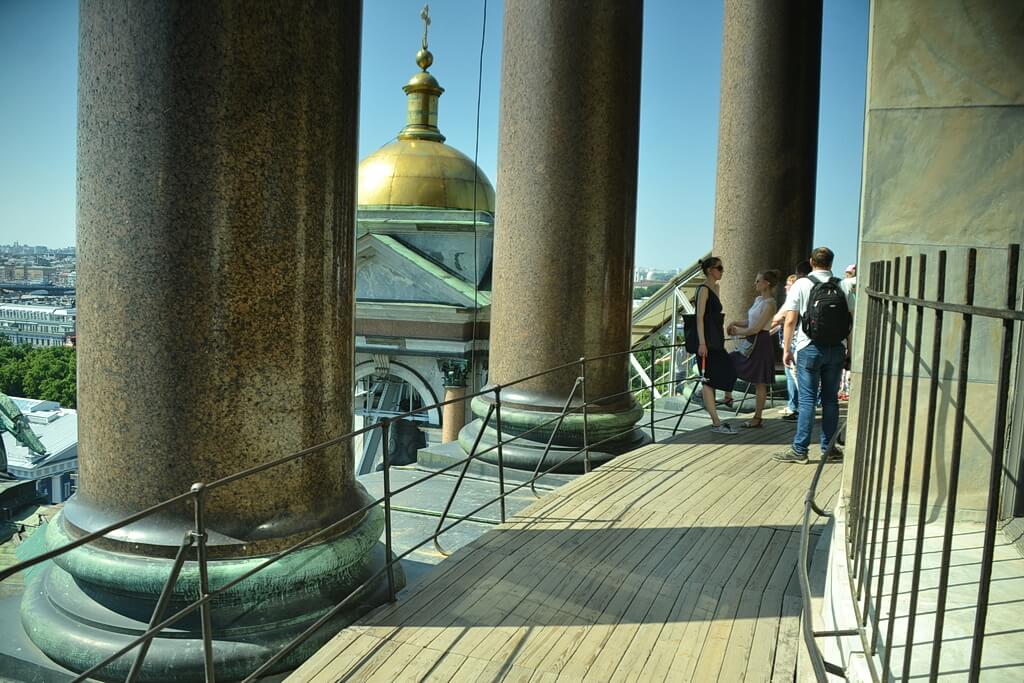
It’s safe there. If even someone falls out, he will land onto constructions just below the colonnade’s passage.
Visit To The Colonnade For Disabled People
Disabled people on wheelchairs can enjoy their 360-degree viewing point at the height of 37 meters, where they are lifted by a specialized elevator to. The tour must be booked in advance by applying at excursisaak@cathedral.ru.
Such tours are provided from April till October daily except Wednesday at 11.00, 11.45, 12.30, 13.15, 14.45, 15.30, and 16.15.
One assistant is allowed.
Attention: electrical wheelchairs are prohibited. You can take a manual wheelchair provided by the museum. Another important note: the museum doesn’t have a WC.
Also, don’t forget to bring a disability certification.
What You Will See From The St. Isaac’s Colonnade
You enter the colonnade near the spot overlooking the south direction. There is a mark on the floor telling it.

Below is Isaac’s square with the building of the city parliament (marked 1), the former residence of Germany’s embassy in Russia and consulate in Leningrad (2), the monument to Nicolas I, Russian Emperor in 1825 – 1855 (3). The monument is often taken by mistake for the monument to Peter the Great, the founder of St. Petersburg, which is on the contrary side of the cathedral.
Number 4 are the hotels Astoria and Angleterre, nice places for many celebrities and politicians to stay.
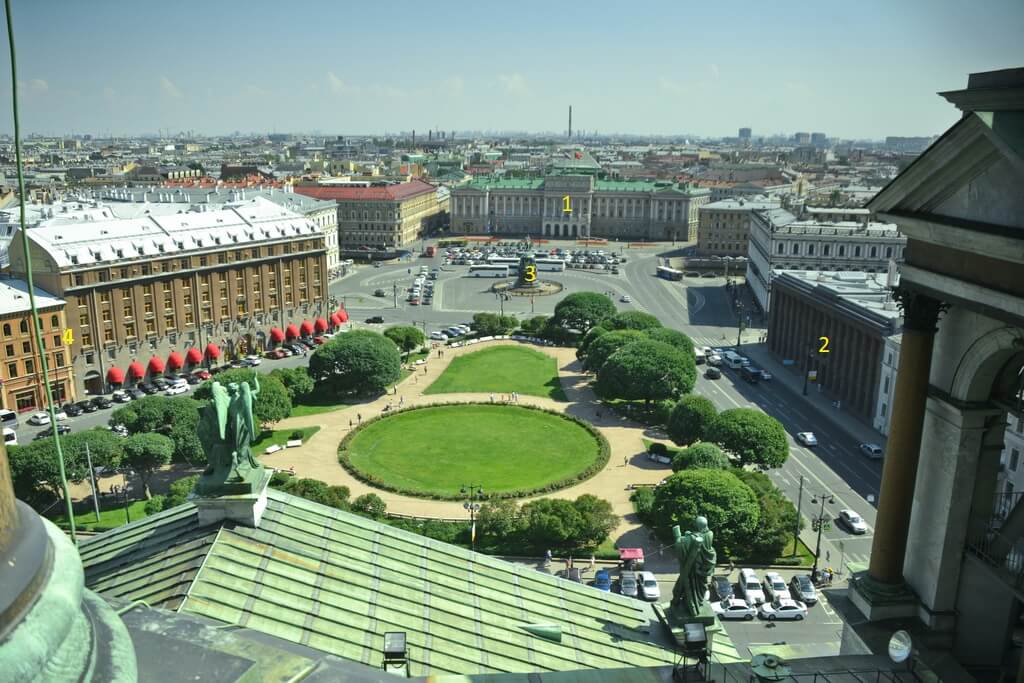
Further going clockwise (no rules in which direction visitors should move at the colonnade), we see cranes in the distance. That’s the port of St. Petersburg, one of the biggest in Russia, and the primary reason why Peter the Great used this spot for a city that later was turned into capital. Now the port handles 50-60 million tons of various cargoes a year.

The cathedral is adorned with figures of Archangels and other sculptures. When looking down, a figure of a sculpture coupled with figures of people on the street helps you feel the height.

From the north side, we see the Neva river, the main river flowing through the city from the lake of Ladoga to the Gulf of Finland. At nights, the river is a way for river and sea vessels to go under raised bridges on their way to or from European ports. Neva is a final stretch of the Volgo Balt shipping canal connecting central Russia with Europe.
The photo was taken at the end of July, a week before Russian Navy Day which is traditionally celebrated with a military parade on Neva. Ships on the photo arrived to take part in the parade.
A bit strange looking skyscraper in the background is the headquarters of the Gazprom company, called also Lakhta center. Now under construction, it is the highest building in Europe, 422 meters tall. City residents dubbed it, as you easily guess, «The Ear of Corn».

The north side overlooks the Senate square, one of the most famous sites in St. Petersburg, where historical events took place. It features the monument to Peter the Great (Peter I of Russia) ordered by Catherine the Great (Catherine II of Russia) and made by Falkone. The monument is also called «The Bronze Horseman».
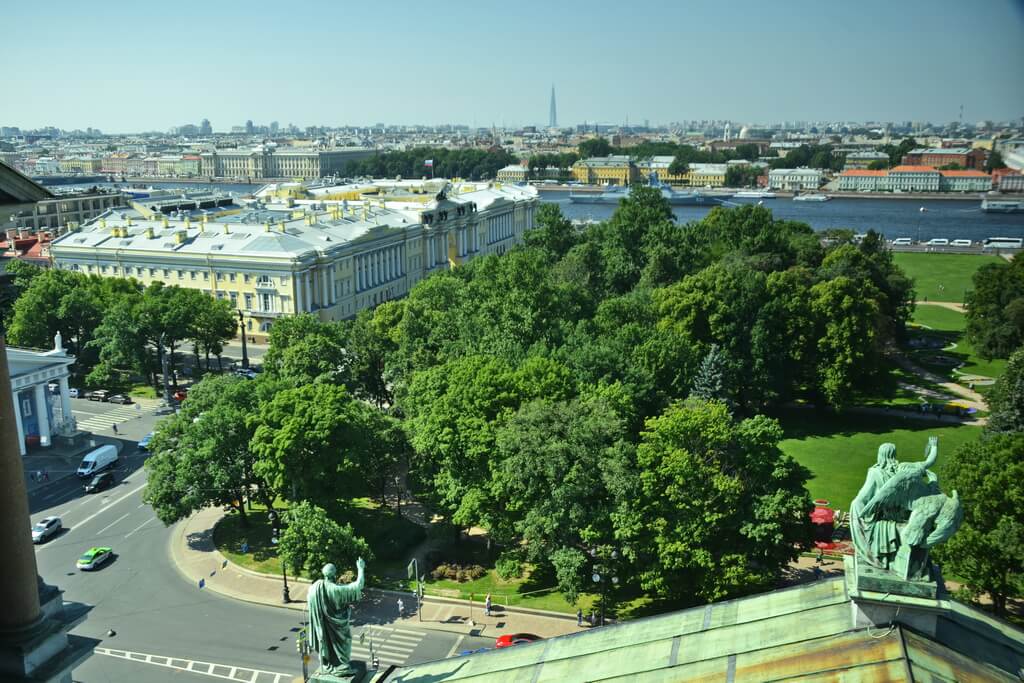
The complex of buildings on the left used to belong to the Synod of the Russian Orthodox Church and the Senate of the Russian Empire. The Synod was the highest administrative and court body of the Church in 1721 – 1917, the Senate was the highest body of the state power in the Russian Empire. Both established by Peter the Great and annihilated by the Bolsheviks in 1917.
Here is a view of the St. Petersburg downtown with the dome of the Kazan Cathedral (located on Nevsky avenue).
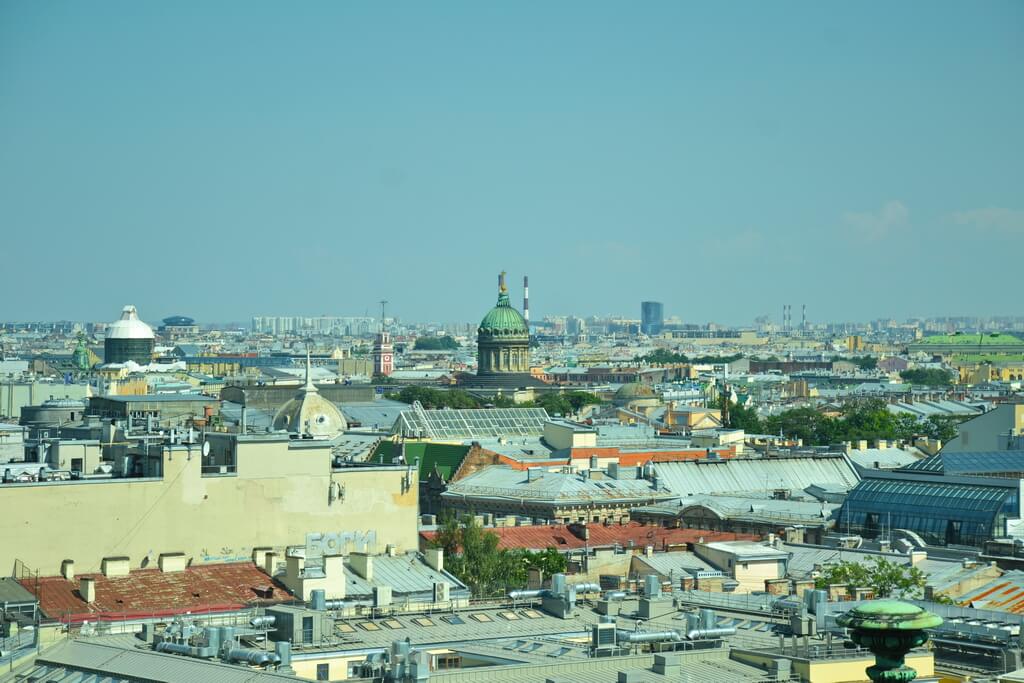
These two spires belong to the Admiralty in the photo below (the closer one) and to the Peter and Paul Cathedral of the Peter and Paul Fortress.
The Admiralty initially erected as a shipbuilding yard, it used to be the headquarters of the Russian Navy, the seat of the Marine Ministry, and other marine-related establishments in 1718 – 1917 and home to marine school and military units in the Soviet time. About 300 vessels were built here from 1706 till 1844. The headquarters of the Russian Navy moved in here in 2012.
The Peter and Paul cathedral is the first building in St. Petersburg. Now it’s home to the crypt of the Romanovs, the ruling family of Russia in 1613 – 1917. The cathedral’s spire you see in the photo is the highest point in the center of St. Petersburg, 122.5 meters.
Both spires are topped with symbols of St. Petersburg. The Admiralty’s one is adorned by a ship (historians have not come to the consensus what was the «prototype» of the vessel), the cathedral’s one is topped by a figure of an angel often referred to as the defendant of the city.
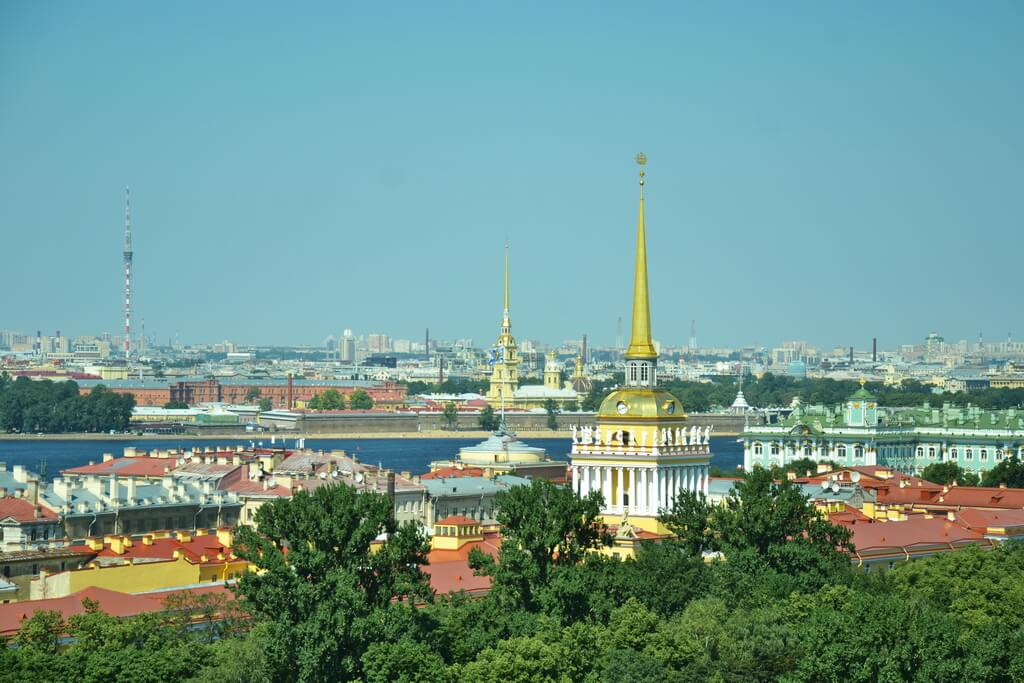
Looking westward, you will see another panorama of roofs with the dome of the Troitsky (Trinity) Cathedral dominating the scene (on the left side).
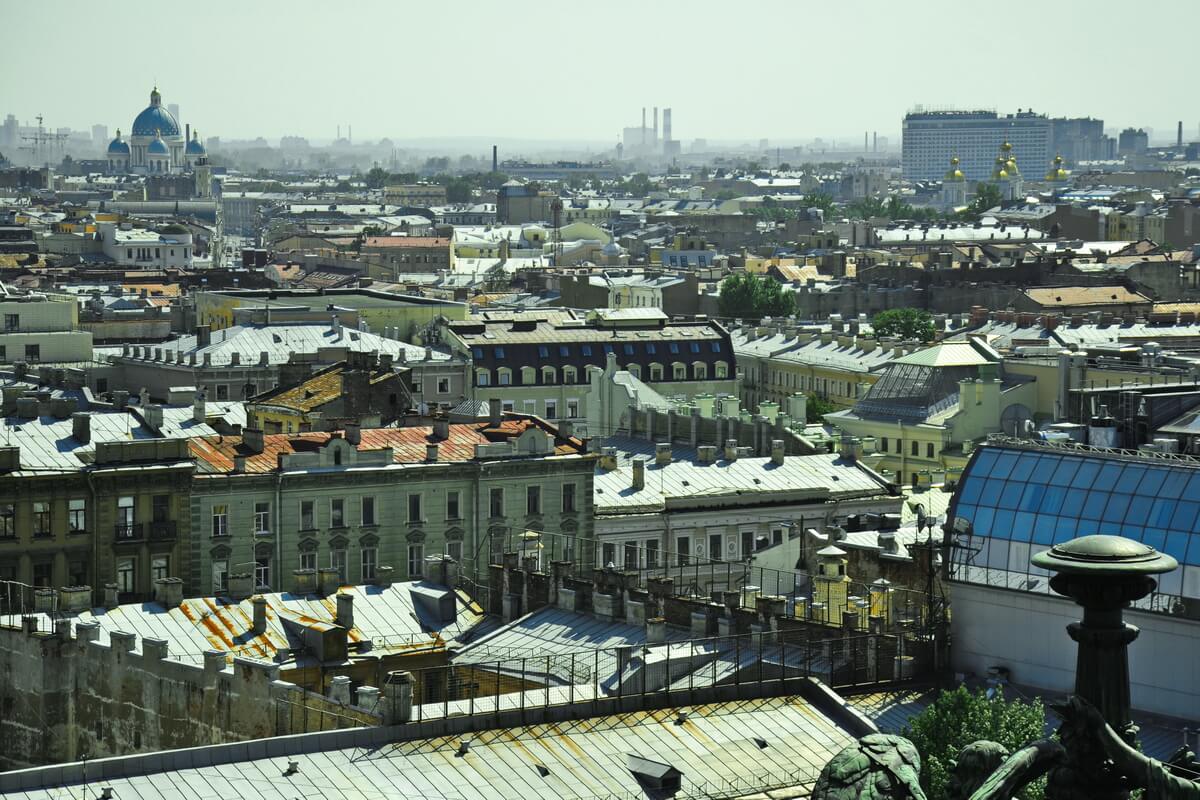
You can spend as much time as you need at the colonnade. It tends to be busy on weekends and on sunny days, while on weekdays (especially on cloudy ones) and at nights it’s rather spacious.